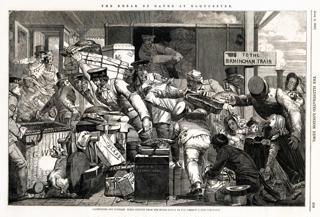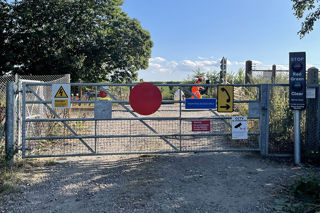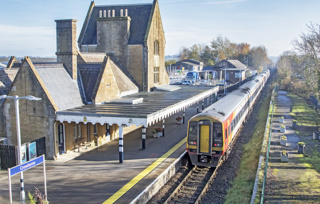The morning of Tuesday January 8 1991 began as a routine one for commuters aboard the overcrowded 0758 service from Sevenoaks to Cannon Street. Any sense of normality had quickly evaporated by 0844, however, when the ten-coach train failed to stop and piled into buffer stops at the end of its 46-minute journey.
There had been little sign of the impending catastrophe awaiting over 800 passengers as the train made its seventh and penultimate stop at London Bridge, rounded the curve at Borough Market Junction, and made its approach into the terminus at Cannon Street. Reducing speed from 20mph to comply with the 15mph speed restriction on the platform approaches, driver Maurice Graham turned off the power and allowed the train to coast into Platform 3.
Those passengers fortunate enough to find a seat during the busy morning peak had already begun rising to their feet, in anticipation of the rush to disembark. And some of the slam doors of the Southern Railway-designed Mk 1 EMU coaches had already been opened, in preparation for the familiar dash across the concourse to offices in the financial heart of the City of London, or slightly further afield via the Tube.
Others folded away their newspapers as one-by-one each carriage slipped from the daylight to beneath the vast steel deck carrying the office blocks that have enveloped the station’s eight platforms since they were built in 1965 (a second construction development was under way at the time of the crash).
For the most part, the absence of squealing brakes failed to register with those preoccupied with keeping their belongings together or with thoughts of the day ahead, or with those who were simply desensitised by hearing its familiar and reassuring sound through frequent exposure.
But still rolling in at an estimated 5-10mph, the train came to a sudden stop when it slammed into the hydraulic buffers, causing one of the highest number of injuries ever registered by a single UK rail crash.
Standing shoulder to shoulder, passengers were violently thrown off their feet, striking luggage racks, fittings and even those seated around them.
Many of the more fortunate passengers escaped with head, face and whiplash injuries, but the worst damage was sustained in the fifth and sixth carriages, which concertinaed together. Spectacularly assisted by the number of open doors, the structural integrity of these coaches completely failed in a ‘telescoping’ fashion, trapping limbs beneath collapsed walls and seats.
Hearing the loud boom, the first rescuers arrived from a nearby building site before emergency services reached the scene within ten to 15 minutes. More than 80 fire fighters and 100 ambulance crew would eventually be deployed, ferrying the injured to St Bartholomew’s Hospital, Guy’s & St Thomas and The Royal London Hospital.
Rescue efforts would be hampered by the risk of aggravating injuries sustained in the badly crushed fifth and sixth carriages. It took two hours to cut free the most serious cases, who were taken to hospitals by air ambulance.
The sheer scale of the number of casualties was unparalleled - 542 people were affected, 277 of them serious enough to require admission to hospital. Tragically two passengers lost their lives. Martin Strivens, a 24-year-old computer programmer from Orpington, succumbed to a heart attack after being cut free from the wreckage, while 59-year-old Patricia McCay from south London died from her wounds three days later.
Remarkably Platforms 5-8 at Cannon Street were re-opened in time for the evening rush hour, and all remaining platforms except Platform 3 were available the following morning.
In the absence of an obvious cause for the failure of the train to stop at buffers, immediate press reports centred on the age of the rolling stock (RAIL 140).
The train consisted of Class 415/6 electric multiple units introduced in the 1960s and Class 415/4 EMUs introduced in the 1950s. These were built to Mk 1 design standards, but rebuilt from earlier vehicles.
The fifth coach of the train had been built on an underframe dating from 1934, and which had subsequently been involved in a collision with a locomotive in 1958. The sixth coach had been built on an underframe dating from 1928.
The possibility of metal fatigue or mechanical failure was given further credence by reports that driver Maurice Graham had immediately told dazed passengers that the brakes had failed while he was at the controls.
This theory was officially discounted 14 months later, by the public inquiry that reported in March 1992. Although the poor structural integrity of ageing rolling stock and its lack of crashworthiness had undoubtedly contributed to the scale of injury, no defect could be found with the train’s braking and traction systems. HM Railway Inspectorate therefore placed blame squarely at the feet of 25-year-old Maurice Graham and driver error, for misjudging his braking distance.
What led to Graham’s failure to effectively apply the brakes was less easy to establish, however, given his refusal to give evidence at the inquiry - on the advice of his lawyers, should it be used against him in any subsequent criminal prosecution.
On one hand, none of the evidence given by passengers suggested any sign of erratic driving for the duration of the journey. Neither the train’s guard nor a fellow driver travelling in the cab with Graham on the 0758 had observed any excessive speeds or sudden braking.
But on the other hand, the driver was found to have traces of cannabis in his blood in a test conducted three days later, although the inquiry was unable to prove whether this had any bearing on his failure to brake properly.
British Rail would go on to receive strong criticism for the long delay in testing Graham for drugs or alcohol, and for the destruction of notes detailing a statement he had made to an Area Traction Manager within an hour of the incident occurring - potentially vital evidence.
As unsatisfactory as the conclusions of the inquiry may have seemed, the report went on to make a total of 15 wide-reaching recommendations intended to improve passenger safety and reduce the possibility of future buffer stop collisions.
Chiefly, it requested the complete withdrawal of Class 415 EMUs, and their replacement by new ‘Networker’ units as quickly as possible. This was not only on account of their age and structural weaknesses, but also in future automatic doors would prevent passengers from opening doors before a train had come to a complete standstill.
This recommendation sadly echoed the findings of an earlier inquiry following the Clapham Junction rail crash, which killed 35 passengers in December 1988. Although the circumstances of this accident were very different - a signal fault caused by human error - Mk 1 EMU rolling stock and its lack of robustness was determined to have greatly contributed to the number of fatalities.
All of the Mk 1 stock has now gone from regular service. All Southern-designed stock was withdrawn by 1995, but it would take a further ten years for the last slam-door Mk 1 EMU to be retired from frontline service post-privatisation in 2005.
The provision of seatbelts and a ban on passengers standing on trains were swiftly ruled out as impracticable, but the report called for better provision of hand-holds and greater consideration for the way luggage is stored in future coach designs.
The inquiry asked for legislation criminalising railway employees with safety responsibilities being impaired by alcohol or drugs, and for laws permitting the mandatory testing of employees involved in safety incidents. In 1991 it was illegal for railway staff to be under the influence of alcohol, but incredibly there was no equivalent law for drugs, effectively ruling out criminal proceedings against Maurice Graham for his proven use of cannabis. This scenario was rectified by the Transport and Works Act 1992.
The inquiry also called for the end of drivers being able to book on for duty unsupervised. In future, train crew would have to book in by telephone or report to a supervisor who could visibly look for signs of unfitness for duty.
This was another recommendation that had previously been made - this time in 1972 in the aftermath of the Eltham Well Hall rail crash, in which six people died following a derailment caused by driver Robert Wilsdon travelling at excessive speed while intoxicated by alcohol.
The provision of ‘black box’ on-train data recorders was requested to provide information about the actions of a driver and the operation of brake and traction systems. This would aid with future accident investigations, by making them far less reliant on driver testimony (which was entirely absent in the case of Cannon Street). A standard for On-Train Monitoring Recorders (OTMR) was published in October 1993.
A recommendation was also made that BR review its training given to drivers concerning the control of trains into terminal platforms. All aspects of driver training have been given attention since 1991, including the development of Professional Driving Policies.
The report also called for Automatic Train Protection (ATP) to be installed across the entire rail network as quickly as possible, and finally that BR install new or modified buffer stops combining sliding and hydraulic designs, which may have helped cushion more of the impact at Cannon Street via a number of retarders placed on the rails behind the buffer stop.
Regrettably, it would require a further fatal accident at Ladbroke Grove in 1999 before Train Protection and Warning System (TPWS), which was considered to be more cost-effective than ATP, made the types of incident at Cannon Street far less likely.
Twenty-five years later, there are no physical signs of the incident remaining at Cannon Street, but its legacy lives on through the safety improvements made in its wake and the robust design of Mk 2 and Mk 3 coaches. It may never be known why Maurice Graham misjudged his braking distance, or failed to brake at all.
- This feature was published in RAIL 792 on January 20 2016

















Michela - 02/07/2018 08:53
I was in this crash. A very interesting read.